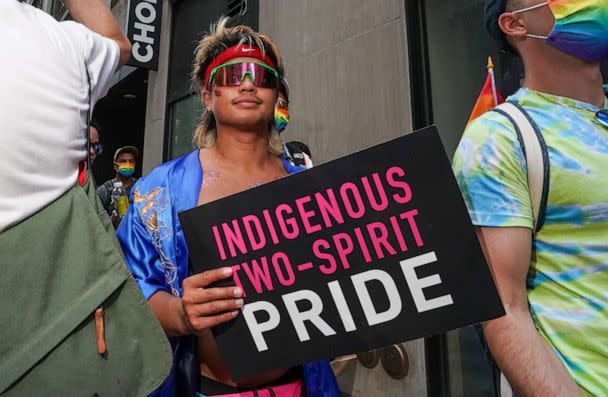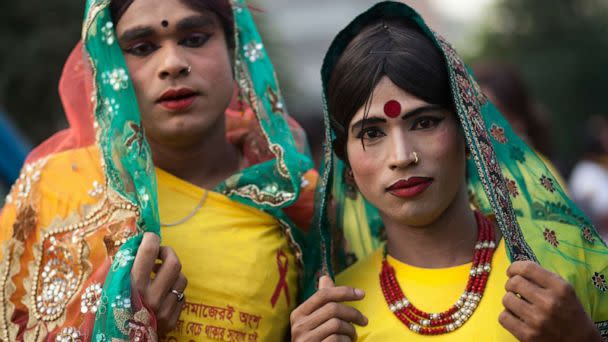LGBTQ people have 'been around for forever,' historians say
- Oops!Something went wrong.Please try again later.

Gender non-conformity is not a new phenomenon or trend – in fact, gender diversity can be seen throughout history in countries around the world – from ancient Greece to India to the Americas, according to historians.
"There is no historically universal way that societies have sorted biologically different people into personhood categories in the way that we do it now," Susan Stryker, a historian and professor, told ABC News in an interview.
In America, gender norms enforce that, for example, a person of the female sex will automatically think of themselves as a girl and live socially as a woman, according to Stryker.
These gender norms and expectations have sparked a heated debate nationwide, as legislators across the U.S. have been targeting gender non-conforming communities through bills that restrict their ability to access gender-affirming care or ability to use their pronouns and preferred names in schools.
Many of the terms used to describe gender diversity today would have been completely foreign to people decades or centuries ago. However, Andrew Shaffer, Director of Development & Communications of the GLBT Historical Society, says the LGBTQ community has "been around for forever."
Historians say that being confined to two genders is not the norm in many cultures.
MORE: What is gender dysphoria and what does transgender youth care consist of?
In some places, strict laws and practices concerning gender from colonizers and missionaries were often imposed upon the places they invaded – including the Americas and South Asia, where more than two genders were embraced, historians have found.
However, discrimination against these groups have still occurred in places where gender non-conformity was well-known.
"Not only have we been around for forever, but we've been really important integral parts of most human societies for as long as there have been human societies," said Shaffer.
Below are just a few examples of gender diversity throughout history and the world:
The Hijra people of South Asia
Non-binary populations have been around for thousands of years in Hindu society across South Asia, according to historians. They hold a powerful position in Hindu society as being able to bless Hindu households, marriages, and births.
The Hijras are made up of a population of people born male who dress in traditionally feminine attire and makeup or who are born intersex, according to a Harvard research study of the demographic.
They're considered to be a third gender, a separate gender from women and men.
In a TEDx Talk, prominent hijra activist Laxmi Narayan Tripathi said she's often asked when she knew she was "different" or when she "came out" as transgender.
"I said I came out only once – from my mother's womb," Tripathi joked.
"The problem is with the world, not with me, you know, because they wanted to box me," she said in the 2017 speech.
Two-spirited, Lhamana people in Indigenous cultures
Two-spirited is an umbrella term that refers to people who possess "both female and male spirits within one body," or a third gender in Indigenous or Native cultures, according to Anya Montiel, a historian and art curator for the Smithsonian National Museum of the American Indian.
However, different Indigenous and Native cultures have other terms for these identities.
Two-spirited people are often seen as "gifted" or "honored" for carrying two spirits, and were often healers and visionaries in their community, according to the Indigenous Foundation.
These populations were present long before the arrival of European colonists, the Indigenous Foundation found, however their stories and status were tarnished following colonization and the strict gender roles imposed by colonizers.

This also means a lot of the history of two-spirited people has not been captured in Western depictions of Indigenous and Native cultures, Montiel told ABC News.
"When you think about the first people to document Indigenous cultures in North America, they tended to be missionaries and anthropologists," said Montiel. "So, most of the times, those people are really thinking from their own cultural viewpoint. Sometimes they didn't talk about any gender variation amongst Native people, or if they did, they spoke about it in a disparaging way."
Ancient Roman gender diversity
In Rome, a group of priests called the Galli worshiped the goddess of Cybele, and castrated themselves as did Cybele's consort Attis, and dressed exclusively in women's clothing, according to the historical preservation organization English Heritage.
The Galli subverted Roman gender norms and helped poets and theorists examine gender, according to English Heritage, however, the Galli were also subject to criticism from those who embraced typical Roman views of masculinity.
Current debate about gender and sexuality in U.S.

In the U.S., recent legislation has sought to restrict gender diversity in some states, with bills popping up across the country that target transgender people, cross-dressing and drag shows, and more.
At least 427 anti-LGBTQ bills have been introduced or considered in 2023 alone, according to the ACLU.
Historians say gender diverse people have long faced discrimination, and in the U.S. the mid-1900s represented an energized push in demands for equality from LGBTQ populations, led by transgender icons such as Marsha P. Johnson and Sylvia Rivera.
However, they too have been celebrated, said Schaffer.
He continued, "We have often been embraced, we have often been an important parts of integral parts of communities, and not just, we haven't always been fighting for our rights. Sometimes they were just granted."
LGBTQ people have 'been around for forever,' historians say originally appeared on abcnews.go.com